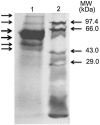Characterization of a virulent ranavirus isolated from marine ornamental fish in India
- PMID: 29291228
- PMCID: PMC5747849
- DOI: 10.1007/s13337-017-0408-2
Characterization of a virulent ranavirus isolated from marine ornamental fish in India
Abstract
A viral agent implicated in the mortality of marine ornamental "Similar Damselfish" (Pomacentrus similis Allen, 1991) was isolated and characterized. The virus grew well in marine and freshwater fish cell lines from seabass and snakehead. The virus was sensitive to chloroform, acidic pH (3.0) and heat treatment at 56 °C. Biochemical characterisation indicated that the virus had double stranded DNA genome. Transmission electron microscopic analysis of ultrathin sections of infected cell pellets showed iridovirus-like icosahedral virus particles of 120-130 nm. Purified virus had six structural protein bands that ranged from of 44 to 132 kDa. PCR analysis confirmed the presence of viral DNA in infected cell cultures and sequence analysis of the major capsid protein gene showed an identity of 99.82% to that of largemouth bass virus. Serum neutralization studies involving the viral agent and koi ranavirus (KIRV) indicated partial homogeneity between the two isolates. Experimental infection of seabass (Lates calcarifer) and similar damselfish (P. similis) fingerlings with the similar damselfish virus showed cumulative mortalities of 68.75 and 93.33%. The biophysical and biochemical properties of the viral agent isolated, serological characteristics, size of major capsid proteins and the sequence similarity of the MCP gene proved that the virus belongs to the genus Ranavirus of the family Iridoviridae. Ability of the virus to grow in marine and freshwater fish cell lines and its pathogenicity to one of the cultivable marine fish shows the wide host range of the virus. This is the first report of ranavirus induced mortality in marine fish in India.
Keywords: Aquaculture; India; Iridoviridae; Ornamental fish; Ranavirus; Seabass.
Figures






Similar articles
-
Isolation and characterization of a ranavirus from koi, Cyprinus carpio L., experiencing mass mortalities in India.J Fish Dis. 2015 Apr;38(4):389-403. doi: 10.1111/jfd.12246. Epub 2014 Apr 10. J Fish Dis. 2015. PMID: 24720625
-
Characterization of a novel ranavirus isolated from grouper Epinephelus tauvina.Dis Aquat Organ. 2003 Jan 22;53(1):1-9. doi: 10.3354/dao053001. Dis Aquat Organ. 2003. PMID: 12608562
-
Detection and characterization of a novel marine birnavirus isolated from Asian seabass in Singapore.Virol J. 2019 May 28;16(1):71. doi: 10.1186/s12985-019-1174-0. Virol J. 2019. PMID: 31138237 Free PMC article.
-
Ranaviruses (family Iridoviridae): emerging cold-blooded killers.Arch Virol. 2002 Mar;147(3):447-70. doi: 10.1007/s007050200000. Arch Virol. 2002. PMID: 11958449 Review.
-
Advances on genomes studies of large DNA viruses in aquaculture: A minireview.Genomics. 2023 Nov;115(6):110720. doi: 10.1016/j.ygeno.2023.110720. Epub 2023 Sep 25. Genomics. 2023. PMID: 37757975 Review.
Cited by
-
Application of Outer Membrane Protein-Based Vaccines Against Major Bacterial Fish Pathogens in India.Front Immunol. 2020 Jul 21;11:1362. doi: 10.3389/fimmu.2020.01362. eCollection 2020. Front Immunol. 2020. PMID: 32849496 Free PMC article. Review.
-
Patterns of infection, origins, and transmission of ranaviruses among the ectothermic vertebrates of Asia.Ecol Evol. 2021 Oct 25;11(22):15498-15519. doi: 10.1002/ece3.8243. eCollection 2021 Nov. Ecol Evol. 2021. PMID: 34824771 Free PMC article. Review.
References
-
- Ahne W, Bremont M, Hedrick RP, Hyatt AD, Whittington RJ. Iridoviruses associated with epizootic haematopoietic necrosis EHN in aquaculture. World J Microbiol Biotechnol. 1997;13:367–373. doi: 10.1023/A:1018563930712. - DOI
-
- Bloch B, Larsen JL. An iridovirus-like agent associated with systemic infection in cultured turbot (Scophthalmus maximus) fry in Denmark. Dis Aquat Org. 1993;15:235–240. doi: 10.3354/dao015235. - DOI
LinkOut - more resources
Full Text Sources
Other Literature Sources
Miscellaneous

